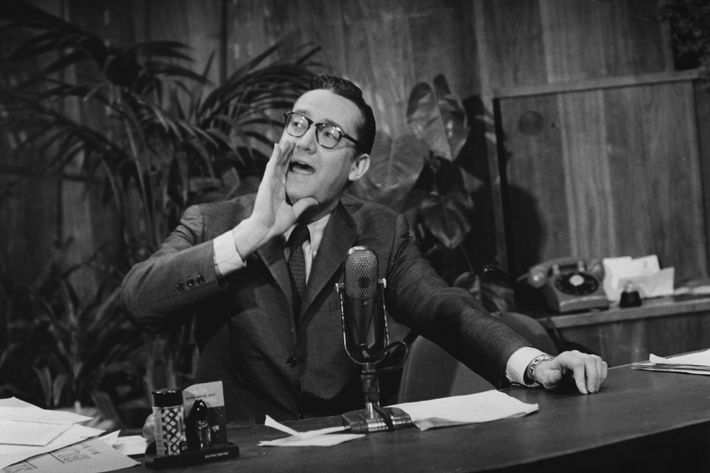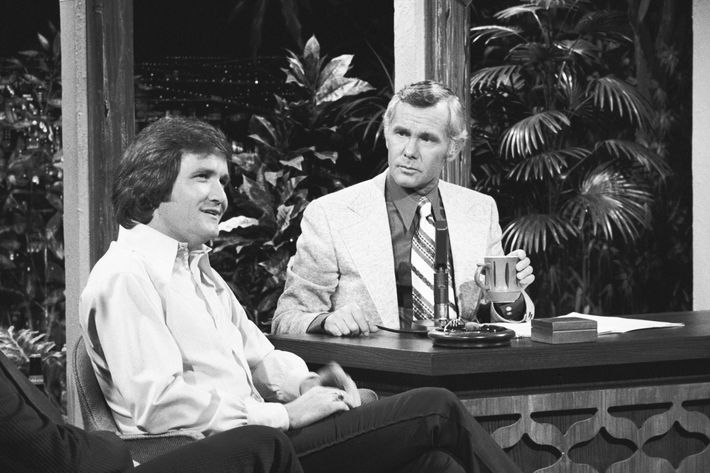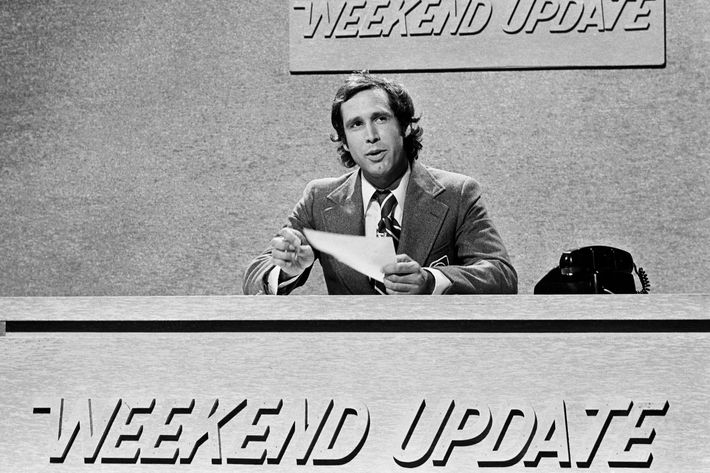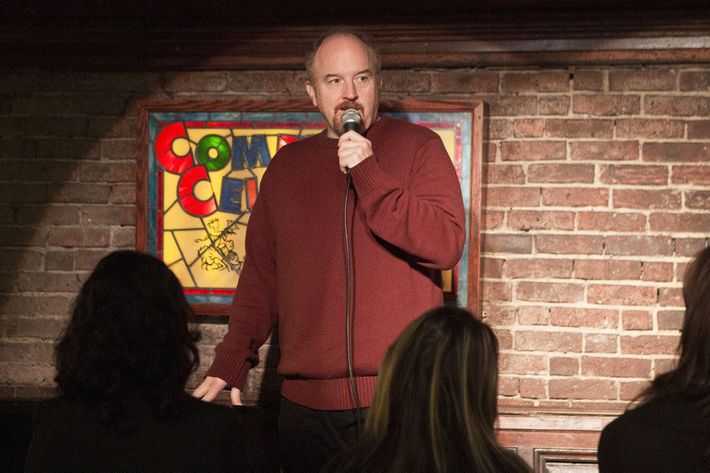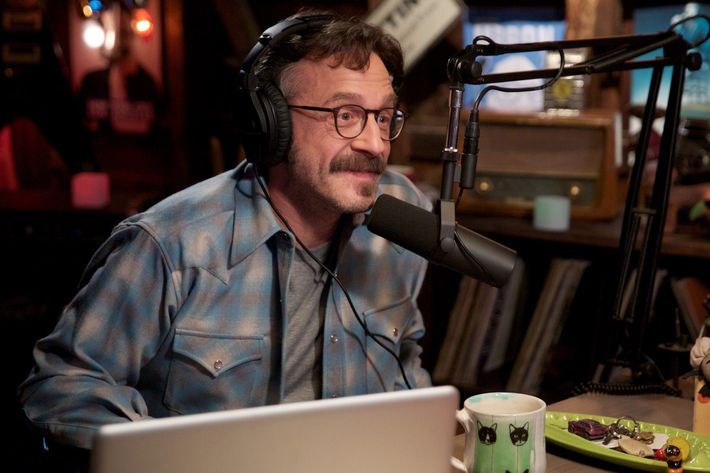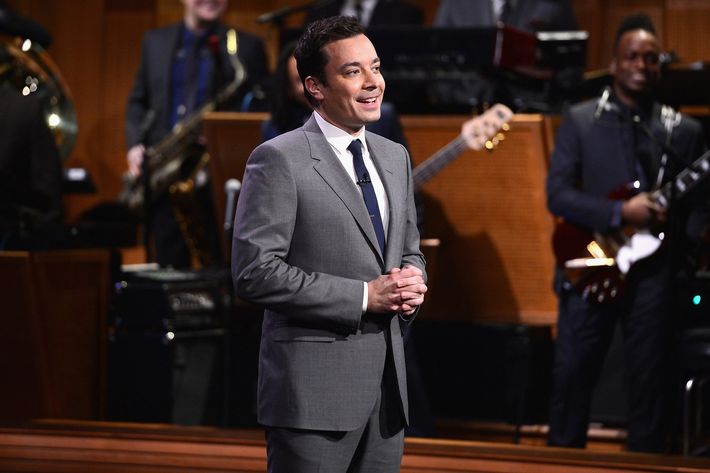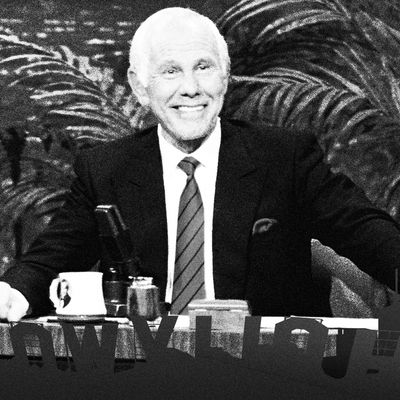
1912: The U.S. government breaks up the New York–based conglomerate Motion Picture Patents Company, a.k.a. the Movie Trust. This paves the way for a newly formed Universal to open studios in L.A. and attract more of the budding film industry.
1928: Each of the big eight film studios now opens in L.A., ushering in the “Golden Age” of film in Hollywood. At the same time, Schenectady stations W2XB and WGY transmit the first-ever televised drama, The Queen’s Messenger, to Los Angeles. Direct lines between the entertainment industries on the two coasts begin to be drawn.
1938: After more than a decade of operating solely out of New York, radio-broadcast rivals NBC and CBS confirm the pull of L.A. by opening studios there.
1939: The earliest commercial-TV experiments begin with NBC station W2XBS, establishing New York as the new medium’s hub of innovation.
1946: Contrary to conventional East Coast wisdom, director Jerry Fairbanks eschews live broadcast and pioneers multi-cam TV production in L.A. Sitcoms are not far behind.
1948: Vaudeville superstar comic Milton Berle hosts first televised variety show, The Texaco Star Theatre, for NBC in NYC. Growing television audiences go nuts.
1951: Despite a network pull to film in New York, Lucille Ball and Desi Arnaz insist on shooting I Love Lucy in L.A. The sitcom soon bumps Texaco as the nation’s No. 1 TV hit.
1954: Tonight Starring Steve Allen — late-night variety talk-show precursor to the juggernaut that is The Tonight Show — begins broadcasting from New York’s Hudson Theater.
1956: The Milton Berle Show, descendant of Texaco Star Theatre, ends its broadcast not in New York but in Los Angeles. Despite Berle’s leap west, The Ed Sullivan Show continues to broadcast out of NYC and showcases early nightclub comics such as Phyllis Diller and Jackie Mason.
1963: Budd Friedman opens his first Improvisation club in New York City as an after-hours spot for performers. While not the two-drink environment that would follow, it became the nation’s first comedy club, as we currently understand it.
1966: Director and former Broadway sketch comedian Mike Nichols comes to L.A. to direct. Nichols’s films The Graduate and Catch-22, among others, will help define New Hollywood.
1972: The Tonight Show With Johnny Carson pulls up New York roots and moves to Burbank. When a set in the new Comedy Store wins young comic Freddie Prinze a life-changing set on Carson, comedians begin to flock to L.A.
HBO, based in Manhattan, becomes the first paid cable-TV service and will soon offer premium, uncensored airtime.
1975: Because Johnny Carson didn’t want NBC to air Tonight Show reruns on Saturdays, NBC gives Lorne Michaels a shot at making a late-night sketch show. Michaels insists that his Saturday Night shoots “live from New York.”
Budd Friedman confirms the expansion of the L.A. stand-up scene when he opens the second Improv, on Melrose.
1976: Chevy Chase shocks SNL by moving to L.A. for more opportunities, but is quickly replaced by Bill Murray.
The L.A. scene continues to ascend as many more East Coasters — like Robin Williams, Jay Leno, Richard Lewis, and Elayne Boosler — migrate west.
HBO records its first anthology comedy special, Freddie Prinze and Friends, at the Improvisation.
The Comic Strip Live — which gives a start to comics such as Eddie Murphy, Jerry Seinfeld, and Chris Rock — opens in NYC.
1979: L.A.’s improv and character hub the Groundlings Theatre, which will supply SNL many cast members over the years, opens its doors under the direction of Gary Austin.
1980: David Letterman leaves L.A. to host the short-lived The David Letterman Show for NBC; he’ll stay in New York for Late Night in 1982 and for Late Show in 1992.
New Yorker Jerry Seinfeld arrives in L.A. — one of the last big comics to move west in this surge.
1981: Carolines, one of the few clubs that will weather this boom-bust decade for stand-up, opens in its first Chelsea location. Another surviving club, the Comedy Cellar, will open one year later in Greenwich Village — images of its cramped basement on shows including Louie make it synonymous with the thriving, gritty New York stand-up scene.
1989: Proving a national audience’s hunger for comedy on basic cable, Comedy Central begins operations in downtown New York City. While production of its earliest blockbuster hit South Park takes place in L.A., later shows, including The Daily Show, are shot in Manhattan.
1993: The UnCabaret, an alt-comedy bellwether, kicks off at Luna Park in L.A. Host Beth Lapides encourages funny people such as David Cross and Janeane Garofalo to perform new, honest material without the constraints of setups and punch lines.
1994: While the Hollywood Improv remains open, its famous progenitor in New York closes its doors. Following the close of famed Manhattan club Catch a Rising Star in 1993, it’s a death knell for the urbanized stand-up scene of the late ’80s.
1996: A newly remodeled Largo, a hub for alt-comedy in L.A., makes room for acts such as Tenacious D and Sarah Silverman.
At the same time, underground New York comedy turns heads with shows including Eating It at Luna Lounge on the Lower East Side.
1998: L.A. beats New York to the punch in creating the first-ever L.A. Comedy Festival — then known as L.A. Fest of Sketch — a weekend of screenings and talent showcases catering to consumers and industry alike.
1999: Three years after its members relocated from Chicago, the Upright Citizens Brigade opens its first theater on 22nd Street in Chelsea in a former strip club. While classes and shows introduce New Yorkers to the anarchic power of improv, the UCBT itself provides a locus for underground comedy in NYC.
2002: Matt Besser is the first of the “UCB 4” — including Amy Poehler, Ian Roberts, and Matt Walsh — to move west. As the industry finds use for comics with improv training over the next decade, many talented UCB students and acolytes will follow suit.
In NYC, Eugene Mirman, Bobby Tisdale, and others make Rififi the heart of the energetic alt-comedy scene.
2004: New York Comedy Festival launches, indicating not only the city’s hunger for stand-up but offering an alternative to the polished TV and film on display in its West Coast counterpart.
2005: A location of UCB Theater opens on Franklin Avenue in Hollywood as a wave of New York UCBT alums, including Paul Scheer and Rob Corddry, head to California.
Meanwhile, Andy Samberg, Akiva Schaffer, and Jorma Taccone of the Lonely Island relocate to New York from L.A. for jobs at SNL; viral-video domination follows.
2009: New York hemorrhages talent: Conan O’Brien and his staff move for a short stint with The Tonight Show (and stay to produce TBS show Conan); shows including Community and Parks and Recreation encourage comics including Donald Glover and Aubrey Plaza to L.A.; Marc Maron, one of the godfathers of New York’s alt-comedy scene in the ’90s, leaves for California — where he now tapes the WTF podcast in his garage. (See the addendum below for the years prominent members of the contemporary New York comedy scene moved to Los Angeles. It documents “the exodus.”
2011: Chris Hardwick forms the Nerdist Theater at Meltdown Comics, a.k.a. Nerdmelt, and the newly renovated Westside Comedy Theater opens in Santa Monica; alt-comedy venues take hold of L.A.
Meanwhile, yet another branch of the UCB Theater opens in the East Village.
2012: Kickstarter helps fund the first Riot L.A., the city’s burgeoning “alternative comedy festival,” which welcomes many recent NYC transplants including Emily Heller, Kurt Braunholer, and Kristen Schaal.
2013: In a rare reversal, stand-ups Nick Turner and Ari Shaffir return from Hollywood to master their craft in New York clubs.
The first ever Brooklyn Comedy Festival kicks off as stand-up pushes further into New York’s gentrifying outer boroughs.
2014: Jimmy Fallon brings The Tonight Show back from L.A. to Carson’s former studio, 6-B in 30 Rock.
Another UCB Theater opens on Sunset Boulevard along with a training center, offices, café, and retail store.
2015: Despite missives from the mayor of L.A., Stephen Colbert kicks off his version of The Late Show in NYC. With James Corden, Jimmy Kimmel, and others in L.A., the spirit of the late-night scene remains divided between the coasts.
Edit: Due to reported inaccuracies, we have removed the list of years that certain comedians moved to LA.
In the last 15 years, New York has lost so much of its comic talent to Los Angeles that hearing another funny person’s plan to move is beyond a nuisance — it’s a cliché. In truth, if you’re a century old, it was probably a cliché when you were born. As soon as we’d mastered bicoastal travel and the entertainment industry found its way west, the give and take between the country’s two largest cities was established. The easiest, most reductive way to look at it — what New York discovers, L.A. polishes — is fun, though not always true. Sure, Johnny Carson single-handedly pushed stand-up west in the ’70s, but Janeane Garofalo and others really started what we might call alt-comedy in L.A. before New York ran with it. The dates below represent an ongoing history, highlighting some of the most significant transfers of talent and industry mettle from one end of the country to another.
